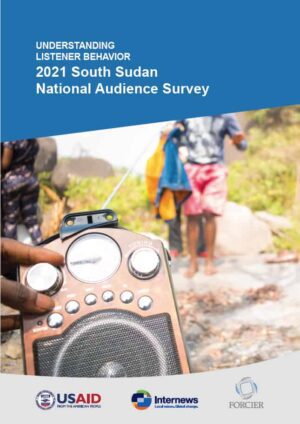Read the Report
From 2020 to 2021, Internews contracted Forcier Consulting to conduct a National Audience Survey in South Sudan to better understand the contemporary national media market with a focus on media consumption, habits, and preferences, as well as beliefs about the reliability of various media sources. The survey objective is to support radio partners to understand the value of their airtime and highlight any unrealized opportunities for deeper audience engagement. Forcier utilized a novel research design combining interactive voice response (IVR) and computer-assisted telephone interviewing (CATI) data collection methods.
This approach produced accurate measures of relevant research indicators, and minimized health risk of COVID-19 and security risk to both researchers and respondents. The combined IVR and CATI samples were constructed based on randomly selected phone numbers from across South Sudan and thus the results can be interpreted as representative of the opinions and preferences of mobile-phone-owning individuals (or individuals who have access to mobile phones) who live in South Sudan.
Conclusions and actionable recommendations to media stakeholders and Internews including:
- Improving access to radio and television in Unity State would likely produce a substantial increase in overall media consumption in Unity State.
- Improving access to smartphones in Warrap State would potentially produce a major increase in internet access/use in Warrap State.
- Women have far more limited phone access and ownership than men, so for Internews access to information interventions, equipping more women with phones could shift women’s access to information and the internet, as well as potentially shifting gender power dynamics in important ways.
- Radio stations across South Sudan can charge the most for advertisements from 4-8 pm in the evening. This is also prime time for television usage.
- Depending on the region, the next most popular radio use time is in the early morning from 5-8 am, and most stations broadcasting in most states can also charge more to advertisers and sponsors for this timeslot than the others.

